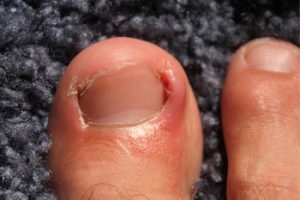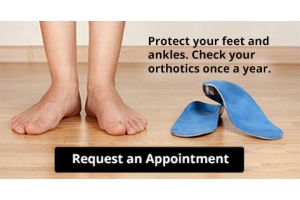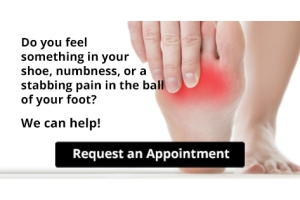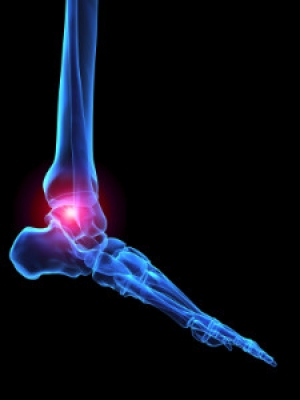
Symptoms of an Ingrown Toenail
 If you notice skin growing on the side your big toe, you may have what is referred to as an ingrown toenail. There may be several noticeable symptoms that are associated with this condition, and these may include extreme tenderness, swelling, and possible drainage from the affected area. If the toenails are not properly trimmed, the result may be an ingrown toenail. Additional reasons why this condition can develop may come from an injury that may have happened to the nail, or if shoes and socks that are worn do not fit correctly. Mild relief may be obtained by soaking the foot in a salt solution. If medical conditions including diabetes or poor circulation exist, it is strongly recommended to seek the counsel of a podiatrist who can offer correct treatment and preventive techniques.
If you notice skin growing on the side your big toe, you may have what is referred to as an ingrown toenail. There may be several noticeable symptoms that are associated with this condition, and these may include extreme tenderness, swelling, and possible drainage from the affected area. If the toenails are not properly trimmed, the result may be an ingrown toenail. Additional reasons why this condition can develop may come from an injury that may have happened to the nail, or if shoes and socks that are worn do not fit correctly. Mild relief may be obtained by soaking the foot in a salt solution. If medical conditions including diabetes or poor circulation exist, it is strongly recommended to seek the counsel of a podiatrist who can offer correct treatment and preventive techniques.
Ingrown toenails can become painful if they are not treated properly. For more information about ingrown toenails, contact Dr. Robert Marcus of Foot & Ankle Center of Teaneck. Our doctor can provide the care you need to keep you pain-free and on your feet.
Ingrown Toenails
Ingrown toenails occur when a toenail grows sideways into the bed of the nail, causing pain, swelling, and possibly infection.
Causes
- Bacterial infections
- Improper nail cutting such as cutting it too short or not straight across
- Trauma to the toe, such as stubbing, which causes the nail to grow back irregularly
- Ill-fitting shoes that bunch the toes too close together
- Genetic predisposition
Prevention
Because ingrown toenails are not something found outside of shoe-wearing cultures, going barefoot as often as possible will decrease the likeliness of developing ingrown toenails. Wearing proper fitting shoes and using proper cutting techniques will also help decrease your risk of developing ingrown toenails.
Treatment
Ingrown toenails are a very treatable foot condition. In minor cases, soaking the affected area in salt or antibacterial soaps will not only help with the ingrown nail itself, but also help prevent any infections from occurring. In more severe cases, surgery is an option. In either case, speaking to your podiatrist about this condition will help you get a better understanding of specific treatment options that are right for you.
If you have any questions please feel free to contact our office located in Teaneck, NJ . We offer the newest diagnostic and treatment technologies for all your foot and ankle needs.
Ingrown Toenail Care
An ingrown toenail is a toenail that grows sideways into the nail bed, causing pain and swelling. Ingrown toenails can worsen and cause drainage, turning into a serious infection.
Several factors affect whether a person is at risk from an ingrown toenail. The many causes include being overweight, diabetes, participating in sports, having a fungal infection of the toe, and cutting your nails too short. Ingrown toenails also have a genetic predisposition, causing some people to be more prone to receive the condition than others. Other causes include improperly fitting shoes and shoes that keep the feet damp.
Ingrown toenails can be preventable with certain measures. For starters, allowing your toe nails to grow slightly longer in length will help prevent them from becoming ingrown. If you have already developed an ingrown toenail, soak the affected toe in warm water. This will alleviate the pain and help prevent an infection from forming. Antibiotic soap or Epsom salts may be added to further help the relieving process and avoid infection. Placing cotton beneath the affected area is also suggested, as this may help the toenail grow upwards and not into the nail bed. Swelling and redness can be reduced by resting with your feet elevated.
A podiatrist should be seen if the pain becomes so serious that it prevents you from doing your everyday activities. If a red streak running up your leg appears or if you suspect your infection has spread, contact a podiatrist immediately. Fast treatments can be undertaken to lessen your pain and have you walking comfortably.
An ingrown toenail can be easily treated with a Band-Aid. Simply wrap the affected toe with a Band-Aid to prevent infection and keep the nail from growing out at a painful angle.
In more serious cases, your podiatrist may decide to make a small incision to remove a portion of your toenail. To prevent the nail from growing back, medication will be placed directly into the nail bed. This procedure would be performed under local anesthesia and is a faster method to alleviate discomfort from an ingrown toenail. Post-procedure directions will have you stay off the affected foot for a day. Afterwards, normal activities can be resumed.
Proper Foot Care Is Essential in Diabetic Patients
 If you are a diabetic patient, it is important to know how to properly care for your feet. It is important to notice if there are any cuts or scrapes, and this may be beneficial in avoiding infections. Many diabetic patients suffer from neuropathy, and this is the inability to feel any sores that may be present on the feet. There are measures that can be implemented to care for diabetic feet, and these may include washing and drying the feet daily, especially between the toes. Additionally, it may be helpful to avoid going barefoot, and to refrain from cutting the toenails. This is typically done by a podiatrist, who is practiced in trimming the toenails correctly. Additionally, wearing shoes that fit properly and wearing socks that are not too tight may be beneficial in helping to care for diabetic feet. If you are diabetic, it is advised that you speak to a podiatrist as quickly as possible who can guide you in how to properly take care of your feet.
If you are a diabetic patient, it is important to know how to properly care for your feet. It is important to notice if there are any cuts or scrapes, and this may be beneficial in avoiding infections. Many diabetic patients suffer from neuropathy, and this is the inability to feel any sores that may be present on the feet. There are measures that can be implemented to care for diabetic feet, and these may include washing and drying the feet daily, especially between the toes. Additionally, it may be helpful to avoid going barefoot, and to refrain from cutting the toenails. This is typically done by a podiatrist, who is practiced in trimming the toenails correctly. Additionally, wearing shoes that fit properly and wearing socks that are not too tight may be beneficial in helping to care for diabetic feet. If you are diabetic, it is advised that you speak to a podiatrist as quickly as possible who can guide you in how to properly take care of your feet.
Diabetic foot care is important in preventing foot ailments such as ulcers. If you are suffering from diabetes or have any other concerns about your feet, contact Dr. Robert Marcus from Foot & Ankle Center of Teaneck. Our doctor can provide the care you need to keep you pain-free and on your feet.
Diabetic Foot Care
Diabetes affects millions of people every year. The condition can damage blood vessels in many parts of the body, especially the feet. Because of this, taking care of your feet is essential if you have diabetes, and having a podiatrist help monitor your foot health is highly recommended.
The Importance of Caring for Your Feet
- Routinely inspect your feet for bruises or sores.
- Wear socks that fit your feet comfortably.
- Wear comfortable shoes that provide adequate support.
Patients with diabetes should have their doctor monitor their blood levels, as blood sugar levels play such a huge role in diabetic care. Monitoring these levels on a regular basis is highly advised.
It is always best to inform your healthcare professional of any concerns you may have regarding your feet, especially for diabetic patients. Early treatment and routine foot examinations are keys to maintaining proper health, especially because severe complications can arise if proper treatment is not applied.
If you have any questions please feel free to contact our office located in Teaneck, NJ . We offer the newest diagnostic and treatment technologies for all your foot and ankle needs.
Diabetic Foot Conditions
According to the American Diabetes Association (ADA), diabetes is a condition that affects approximately 23.6 million Americans. Around 750,000 new cases are diagnosed each year, and the disease’s most common form, Type 2 diabetes, makes up for 90 to 95 percent of these cases. Type 2 diabetes is especially prevalent among older Americans, those who are obese, and those who lead sedentary lifestyles.
Complications of the disease may lead to several foot and ankle-related conditions. The loss of nerve sensation, or neuropathy, can cause diabetics to lose feeling at the bottom of the feet and therefore leave them unaware of pain, pressure, and heat. Decreased circulation is another complication of diabetes that can slow down the healing of wounds and injuries; this can lead to the development of foot ulcers.
To prevent foot ulcers from forming, diabetics should examine their feet every day for small cuts and wear shoes that curtail pressure. Constant monitoring for the risk factors associated with ulcer formation can allow for early detection and therefore lessen the possibility of ulcers or, even worse, amputation. The removal of calluses and ingrown toenails should be left to the podiatrist to avoid improper removal and possible infection.
Diabetic patients may also experience foot deformities due to complications in their feet, such as limited joint mobility, muscle atrophy, and decreased fat padding. These complications can increase pressure in certain areas of the foot, which in turn can cause certain deformities, such as hammertoe, to form. Another deformity, Charcot foot, develops due to the collapsing of microfractures in the bones of the feet. The resulting deformity is a foot that is flattened and wider in appearance.
To help minimize pressure and prevent the development of these diabetes-related foot and ankle conditions, your podiatrist may consider using orthotics or special shoes. Charcot foot may be treated using walkers, custom orthotic insoles, or non-weight-bearing or rigid weight-bearing casts or braces. In more serious cases, surgery may be considered to treat more developed deformities. Ulcers can be further cared for with the help of proper diet, medication to control glucose, intensive wound care, and infection treatment.
Reminder: When Was the Last Time...?
Everything You Need to Know About Corns
Corns are hard and thick areas of skin that form as a result of constant rubbing, friction, or pressure on the skin. They are patches of dead skin with a small plug toward the center. They may appear on the tops and sides of toes and can make walking painful.
Soft corns are typically thinner with a white color and rubbery texture. Soft corns tend to appear between the toes. Seed corns are another type of corn that appear in clusters and can be tender if they are on a weight-bearing part of the foot. Seed corns usually appear on the bottom of the foot and are likely caused by a blockage in sweat ducts.
While corns and calluses are somewhat similar, calluses are a bit different. Calluses are a patch of dead skin that can occur anywhere on the body. In comparison to corns, calluses are usually a bit larger in size. However, both corns and calluses are caused by increased friction on the skin.
There are some risk factors that may increase your chances of developing corns and calluses. If you have bunions, hammertoe, or a bone spur, you are more likely to develop a corn or callus on your foot.
While Corns and Calluses tend to disappear when the friction to the affected area ceases, the help of a podiatrist may be useful in the removal process. It is important to remove the dead skin around the area and this may be done in a few different ways. Moisturizing creams may be helpful in softening and removing the dead skin around the callus. You should never use razors or other pedicure equipment to remove your corns. Doing this may worsen your corn or callus and cause infection.
In some cases, corns and calluses may be caused by abnormal foot structure or walking motion. In such a case, you should seek a podiatrist’s assistance in order to correct the issue.
Finding the Right Shoe
 Most people know their shoe size and stick with it for life, but a proper shoe fitting could lead to better overall foot health. There are so many types of footwear, but everyone has specific needs when it comes to what is right for their foot. A proper shoe fitting involves both length and width. A shoe should have a wide enough toe box for the natural shape of an individual’s foot, as well as appropriate arch support. Some shoes provide mobility, while others hinder one’s mobility. A shoe that provides the greatest mobility for your feet, ankles, and legs is the best option. The foot is the first place to absorb the weight of our movements, therefore the wrong shoe can negatively affect all weight-bearing bones. If you would like more information on the right shoe for you, then it is recommended you consult with a podiatrist.
Most people know their shoe size and stick with it for life, but a proper shoe fitting could lead to better overall foot health. There are so many types of footwear, but everyone has specific needs when it comes to what is right for their foot. A proper shoe fitting involves both length and width. A shoe should have a wide enough toe box for the natural shape of an individual’s foot, as well as appropriate arch support. Some shoes provide mobility, while others hinder one’s mobility. A shoe that provides the greatest mobility for your feet, ankles, and legs is the best option. The foot is the first place to absorb the weight of our movements, therefore the wrong shoe can negatively affect all weight-bearing bones. If you would like more information on the right shoe for you, then it is recommended you consult with a podiatrist.
Finding a properly-fitting shoe is important in reducing injuries and preventing foot problems. For more information about treatment, contact Dr. Robert Marcus from Foot & Ankle Center of Teaneck. Our doctor will treat your foot and ankle needs.
Proper Shoe Fitting
A common concern when it comes to foot health, having properly fitted shoes can help prevent injuries to the foot. Out feet affect our posture and gait, which in turn affects the biomechanics and overall bodily structure. With 33 joints, 26 bones, and over 100 ligaments, the potential for serious injury is much greater than one realizes. Although the feet cease growth in adulthood, they still change shape as they mature. Here are some factors to consider when it comes to investing in proper fitting shoes:
- Be sure the shoes fit correctly right away
- Ensure the ball of your foot fits comfortably in the widest portion of the shoes
- Even though they may look fashionable, improper fitting shoes can either create adverse conditions or exacerbate existing ones you may already have
- Walk along a carpeted surface to ensure the shoes comfortably fit during normal activity
Keeping in mind how shoes fit the biomechanics of your body, properly-fitting shoes are vitally important. Fortunately, it is not difficult to acquire footwear that fits correctly. Be sure to wear shoes that support the overall structure of your body. Do your feet a favor and invest in several pairs of well-fitted shoes today.
If you have any questions please feel free to contact our office located in Teaneck, NJ . We offer the newest diagnostic and treatment technologies for all your foot and ankle needs.
Proper Shoe Fitting
When it comes to maintaining foot health, wearing properly-fitting shoes is important. While wearing the appropriate pair of shoes may seem like a trivial concern, the reality is that improperly fitted shoes cause an astounding amount of injuries to the feet. The overall structure and the biomechanics of our bodies are directly affected by our posture, gait, and feet. Because of this, pain and discomfort felt throughout the body are often related to a problem in the feet. And, most foot problems usually stem from improper footwear.
Shoes should not be purchased with the expectation that they will easily stretch and contort to the size and shape of your feet. When shopping for footwear, look for shoes that fit correctly and comfortably as soon as you put them on. Do not purchase shoes that are too large or that slip in the heel area when you walk. Do not choose shoes that are loose with the intention of wearing thicker socks to compensate for the space. The widest portion of the shoe, the ball of the foot, must be made sure to fit comfortably in the shoe.
Keeping all of these suggestions in mind may be difficult when shopping and when trying to select from a wide array of different shoes. Nonetheless, your time and money will be wasted if you purchase a pair of shoes that are too uncomfortable for you to actually wear them. After finally selecting and purchasing a pair of shoes, try them on at home. To truly ensure whether or not your shoes fit comfortably with normal activity, walk around on a carpeted surface to determine how they feel on your feet.
The possibility of damaging your feet’s 33 joints, 26 bones, and 100+ ligaments is much higher than many people suspect. Finding an appropriate and properly-fitted pair of shoes is perhaps the single most important action you can take to maintain excellent foot health and help prevent injury. The fact that our feet continue to change with age is one that many people often forget. Even if our feet no longer change in size when we mature, our feet will still change in shape.
If you already have pre-existing foot problems, there is a greater possibility that wearing improperly-fitted shoes will worsen those problems. The good news, however, is that appropriate footwear is not difficult to find. While shopping for shoes, remember that improper footwear can detrimentally affect the feet, the entire body and its biomechanical structure as well. The shoes you wear can greatly impact your legs, back, and entire body, as your posture and gait are related to your feet. Finding and selecting the best properly-fitted shoes is necessary in achieving optimal health.
Why Live with Pain and Numbness in Your Feet?
Wearing Correct Footwear May Help Arthritis
 The feet consist of numerous bones, joints, tendons, and ligaments, and a painful condition known as arthritis may affect the feet as the aging process occurs. Arthritis typically affects the joints, and many patients notice changes in the arch of the foot. There are different types of arthritis that affect many people, including rheumatoid arthritis and gout. Patients who are afflicted with this painful condition may find moderate relief by wearing shoes that fit correctly, in addition to possibly adding insoles to your footwear. Additionally, specific medications may be prescribed which may aid in alleviating the pain that is often associated with arthritis. If you feel you are in the beginning stages of this uncomfortable foot condition, it is suggested that you counsel with a podiatrist who can recommend specific treatments which may lessen any pain that is experienced.
The feet consist of numerous bones, joints, tendons, and ligaments, and a painful condition known as arthritis may affect the feet as the aging process occurs. Arthritis typically affects the joints, and many patients notice changes in the arch of the foot. There are different types of arthritis that affect many people, including rheumatoid arthritis and gout. Patients who are afflicted with this painful condition may find moderate relief by wearing shoes that fit correctly, in addition to possibly adding insoles to your footwear. Additionally, specific medications may be prescribed which may aid in alleviating the pain that is often associated with arthritis. If you feel you are in the beginning stages of this uncomfortable foot condition, it is suggested that you counsel with a podiatrist who can recommend specific treatments which may lessen any pain that is experienced.
Arthritis can be a difficult condition to live with. If you are seeking treatment, contact Dr. Robert Marcus from Foot & Ankle Center of Teaneck. Our doctor can provide the care you need to keep you pain-free and on your feet.
Arthritic Foot Care
Arthritis is a term that is commonly used to describe joint pain. The condition itself can occur to anyone of any age, race, or gender, and there are over 100 types of it. Nevertheless, arthritis is more commonly found in women compared to men, and it is also more prevalent in those who are overweight. The causes of arthritis vary depending on which type of arthritis you have. Osteoarthritis for example, is often caused by injury, while rheumatoid arthritis is caused by a misdirected immune system.
Symptoms
- Swelling
- Pain
- Stiffness
- Decreased Range of Motion
Arthritic symptoms range in severity, and they may come and go. Some symptoms stay the same for several years but could potentially get worse with time. Severe cases of arthritis can prevent its sufferers from performing daily activities and make walking difficult.
Risk Factors
- Occupation – Occupations requiring repetitive knee movements have been linked to osteoarthritis
- Obesity – Excess weight can contribute to osteoarthritis development
- Infection – Microbial agents can infect the joints and trigger arthritis
- Joint Injuries – Damage to joints may lead to osteoarthritis
- Age – Risk increases with age
- Gender –Most types are more common in women
- Genetics – Arthritis can be hereditary
If you suspect your arthritis is affecting your feet, it is crucial that you see a podiatrist immediately. Your doctor will be able to address your specific case and help you decide which treatment method is best for you.
If you have any questions, please feel free to contact our office located in Teaneck, NJ . We offer the newest diagnostic and treatment technologies for all your foot care needs.













